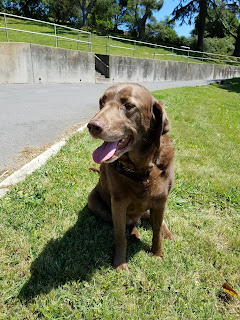How can we “unlearn” symptoms? I remember learning trigonometry in high school, and then never used it again. Eventually, I forgot how to do it — I “unlearned” trigonometry.
If we want to “unlearn” pain, we have to stop “using” it. To understand how, it helps to know something about dog training.
How is the brain like a puppy dog?
If you’ve ever trained a dog, you know that it takes a lot of time, patience, and repetition.
The trainer also needs to have three very important qualities:
- Stay positive
- Be consistent
- Always “catch it in the act”
When I walk in the house and see my dog with her nose in the garbage, I want to interrupt that behavior as fast as I can (in a neutral way) and then immediately get my dog to demonstrate a positive behavior so I can praise her: “good dog!” It looks like this:
• Stop! (Catch it in the act)
• Come, sit! (Be consistent)
• Good dog! (Stay positive)
On the other hand, if I come home and see garbage on the kitchen floor, with the dog happily lying on her bed in the other room, I’ve lost my opportunity for training. If I call her into the room and show her the garbage, she doesn’t understand. There is no perceived connection between the garbage and her doggy brain. That is why I have to “catch her in the act”!
Similarly, if I want to extinguish a symptom (remember that symptoms are reinforced by connections and pathways in the brain) I can “catch it in the act” by
- immediately noticing that I have pain, or anxiety, or depression (whatever symptom I have) stopping the experience of the symptom right now by taking my attention away from the symptom itself and
- quickly counter-stimulating the brain using one of many positive attention-grabbing techniques, such as telling my brain to stop! the symptom, and remembering a fun activity, thus
- helping my brain feel like my dog, “wonderful, good, happy brain!”
Consistency
We learn from dog training that when the trainer makes a mistake (gets tired, overworked, doesn’t feel well) and does not immediately stop the unwanted behavior, the training itself will ultimately be more challenging and take longer, leading to more garbage on the floor!
Training the brain (unlearning symptom-related pathways) requires
- interrupting the experience of the symptom every time we notice it
- developing many techniques (tools) — immediate positive and engaging experiences — to counter-stimulate the brain (like singing, looking at photos of vacations, or viewing pet videos!)
- patience and persistence — changing the brain is a slow process!
Why is it so important to interrupt the symptom as soon as we notice it?
The answer has to do with the rules of Neuroplasticity — how it works in the brain:
- What is fired is wired (and nerves that fire together wire together): When brain cells (nerves) are activated, cell by cell, it makes a pathway (set of connections between nerves) that stays in the brain. Repetition strengthens the connections/pathways.
- Nerves that are activated at the same time in the same place make connections and pathways together
- Use it or lose it: The pathways that have been created in the brain disappear if you don’t keep using them!
- When you make them you break them; when you break them you make them: In order to make new connections (pathways) in the brain, existing connections are broken; in order to break existing connections (pathways) in the brain, new connections must be made. This way the brain conserves its resources.

We want the brain’s “use it or lose it” principle to break up connections and pathways that reinforce symptoms of chronic pain/discomfort, anxiety, and depression.
- The brain will do this only when symptom-related connections and pathways are not being “used.”
- Therefore, we must interrupt the experience of the symptoms as quickly as possible to stop “using” those pathways.
The brain keeps changing – we can do it!
When we consistently interrupt the experience of our symptoms, eventually the brain will decide that the symptom-related pathways are no longer being “used.” That is when the “use it or lose it” principle will be activated. Pathways associated with pain, anxiety, depression, and other symptoms will be broken up to help the brain make new positive connections and pathways. As pathways are broken up, symptoms reduce more and more. I’ve been using this practice for almost six years, and experience vastly reduced pain and greatly expanded energy and abilities. The puppy dog in my brain is as happy and well-trained as my wonderful dog Grace.
Learn how to do it for yourself in my group:
A Change of Mind: Neuroplastic Tools for Healing
In-person:
Monday evenings 6:00–8:00 p.m.
Starts October 8, 2018
Starts October 8, 2018
Tuesday mornings 11 a.m.–1:00 p.m.
Starts October 9, 2018
Starts October 9, 2018
Online:
Wednesdays 3:30–5:30 p.m. PDT
Starts October 17, 2018
Starts October 17, 2018
Individual Appointments Available
